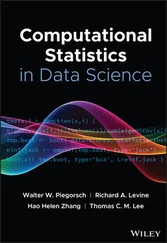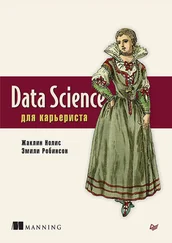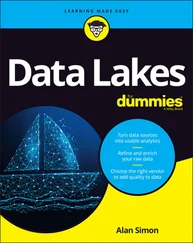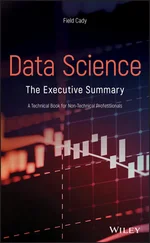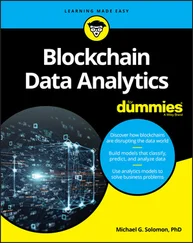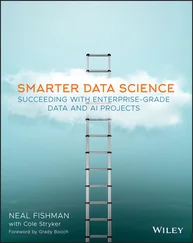 The Technical Stuff icon marks information of a highly technical nature that you can normally skip.
The Technical Stuff icon marks information of a highly technical nature that you can normally skip.
 The Warning icon tells you to watch out! It marks important information that may save you headaches.
The Warning icon tells you to watch out! It marks important information that may save you headaches.
Data Science For Dummies, 3rd Edition, comes with a handy Cheat Sheet that lists helpful shortcuts as well as abbreviated definitions for essential processes and concepts described in the book. You can use this feature as a quick-and-easy reference when doing data science. To download the Cheat Sheet, simply go to www.dummies.com and search for data science for dummies cheat sheet in the Search box.
If you’re new to data science, you’re best off starting from Chapter 1and reading the book from beginning to end. If you already know the data science basics, I suggest that you read the last part of Chapter 1, skim Chapter 2, and then dig deep into all of Parts 3and 4.
Part 1
Getting Started with Data Science
IN THIS PART …
Get introduced to the field of data science.
Delve into vital data engineering details.
Discover your inner data superhero archetype.
Chapter 1
Wrapping Your Head Around Data Science
IN THIS CHAPTER
 Deploying data science methods across various industries
Deploying data science methods across various industries
 Piecing together the core data science components
Piecing together the core data science components
 Identifying viable data science solutions to business challenges
Identifying viable data science solutions to business challenges
 Exploring data science career alternatives
Exploring data science career alternatives
For over a decade now, everyone has been absolutely deluged by data. It’s coming from every computer, every mobile device, every camera, and every imaginable sensor — and now it’s even coming from watches and other wearable technologies. Data is generated in every social media interaction we humans make, every file we save, every picture we take, and every query we submit; data is even generated when we do something as simple as ask a favorite search engine for directions to the closest ice cream shop.
Although data immersion is nothing new, you may have noticed that the phenomenon is accelerating. Lakes, puddles, and rivers of data have turned to floods and veritable tsunamis of structured, semistructured, and unstructured data that’s streaming from almost every activity that takes place in both the digital and physical worlds. It’s just an unavoidable fact of life within the information age.
If you’re anything like I was, you may have wondered, “What’s the point of all this data? Why use valuable resources to generate and collect it?” Although even just two decades ago, no one was in a position to make much use of most of the data that’s generated, the tides today have definitely turned. Specialists known as data engineers are constantly finding innovative and powerful new ways to capture, collate, and condense unimaginably massive volumes of data, and other specialists, known as data scientists, are leading change by deriving valuable and actionable insights from that data.
In its truest form, data science represents the optimization of processes and resources. Data science produces data insights — actionable, data-informed conclusions or predictions that you can use to understand and improve your business, your investments, your health, and even your lifestyle and social life. Using data science insights is like being able to see in the dark. For any goal or pursuit you can imagine, you can find data science methods to help you predict the most direct route from where you are to where you want to be — and to anticipate every pothole in the road between both places.
Seeing Who Can Make Use of Data Science
The terms data science and data engineering are often misused and confused, so let me start off by clarifying that these two fields are, in fact, separate and distinct domains of expertise. Data science is the computational science of extracting meaningful insights from raw data and then effectively communicating those insights to generate value. Data engineering, on the other hand, is an engineering domain that’s dedicated to building and maintaining systems that overcome data processing bottlenecks and data handling problems for applications that consume, process, and store large volumes, varieties, and velocities of data. In both data science and data engineering, you commonly work with these three data varieties:
Structured: Data that is stored, processed, and manipulated in a traditional relational database management system (RDBMS) – an example of this would be a MySQL database that uses a tabular schema of rows and columns, making it easier to identify specific values within data that’s stored within the database.
Unstructured: Data that is commonly generated from human activities and doesn’t fit into a structured database format. Examples of unstructured data is data that comprises email documents, Word documents or audio / video files.
Semistructured: Data that doesn’t fit into a structured database system but is nonetheless organizable by tags that are useful for creating a form of order and hierarchy in the data. XML and JSON files are examples of data that comes in semi-structured form.
It used to be that only large tech companies with massive funding had the skills and computing resources required to implement data science methodologies to optimize and improve their business, but that’s not been the case for quite a while now. The proliferation of data has created a demand for insights, and this demand is embedded in many aspects of modern culture — from the Uber passenger who expects the driver to show up exactly at the time and location predicted by the Uber application to the online shopper who expects the Amazon platform to recommend the best product alternatives for comparing similar goods before making a purchase. Data and the need for data-informed insights are ubiquitous. Because organizations of all sizes are beginning to recognize that they’re immersed in a sink-or-swim, data-driven, competitive environment, data know-how has emerged as a core and requisite function in almost every line of business.
What does this mean for the average knowledge worker? First, it means that everyday employees are increasingly expected to support a progressively advancing set of technological and data requirements. Why? Well, that’s because almost all industries are reliant on data technologies and the insights they spur. Consequently, many people are in continuous need of upgrading their data skills, or else they face the real possibility of being replaced by a more data-savvy employee.
The good news is that upgrading data skills doesn’t usually require people to go back to college, or — God forbid — earn a university degree in statistics, computer science, or data science. The bad news is that, even with professional training or self-teaching, it always takes extra work to stay industry-relevant and tech-savvy. In this respect, the data revolution isn’t so different from any other change that has hit industry in the past. The fact is, in order to stay relevant, you need to take the time and effort to acquire the skills that keep you current. When you’re learning how to do data science, you can take some courses, educate yourself using online resources, read books like this one, and attend events where you can learn what you need to know to stay on top of the game.
Читать дальше
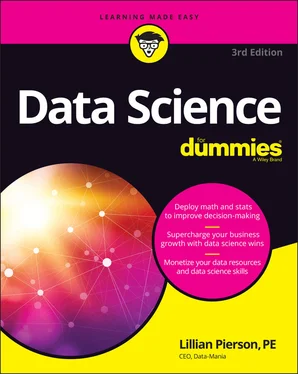
 The Technical Stuff icon marks information of a highly technical nature that you can normally skip.
The Technical Stuff icon marks information of a highly technical nature that you can normally skip. The Warning icon tells you to watch out! It marks important information that may save you headaches.
The Warning icon tells you to watch out! It marks important information that may save you headaches. Deploying data science methods across various industries
Deploying data science methods across various industries![Роман Зыков - Роман с Data Science. Как монетизировать большие данные [litres]](/books/438007/roman-zykov-roman-s-data-science-kak-monetizirova-thumb.webp)

